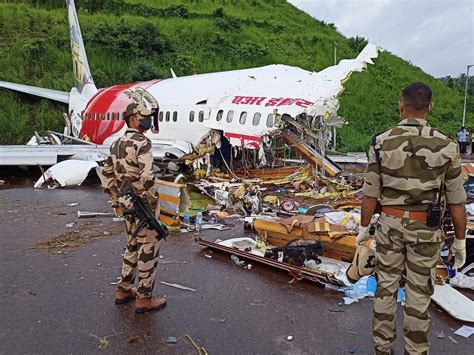
Air India has initiated a comprehensive safety review and adjusted its international flight schedules following a recent incident involving one of its aircraft. The airline is temporarily reducing the frequency of some international routes to ensure operational safety and allow for thorough inspections and necessary maintenance.
Air India is conducting a comprehensive safety review across its operations and has temporarily adjusted some international flight frequencies after a recent incident. The airline aims to reinforce its commitment to passenger safety and operational excellence through these measures.
The move to reduce certain international flight frequencies will allow Air India to conduct detailed inspections of its fleet and implement enhanced safety protocols. The airline stated that these changes are being made proactively to ensure the highest standards of safety are maintained, even though the specific nature of the ‘recent incident’ was not disclosed in detail.
“Safety is our top priority,” an Air India spokesperson said. “We are undertaking a thorough review of our safety procedures and implementing changes to ensure the continued well-being of our passengers and crew. The adjustments to our international flight schedules are a temporary measure to allow us the necessary time and resources to complete this review.”
The airline’s decision comes as the aviation industry faces increased scrutiny over safety standards, and airlines are under pressure to demonstrate their commitment to rigorous maintenance and operational oversight. While specific details about the incident prompting the safety review are scarce, the adjustments to the flight schedule indicate a cautious and proactive approach by Air India to address potential safety concerns.
Impact on International Routes
The adjustments to Air India’s international flight schedules will primarily affect routes with multiple daily or weekly flights. The airline has not specified which routes are affected, but it is expected that destinations with high frequency services will see a reduction in flights. Passengers are advised to check the Air India website or contact the airline directly for the most up-to-date information on their specific flights.
The reduction in flight frequencies could lead to some disruption for passengers, including potential delays and rescheduling. Air India has stated it is committed to minimizing the impact on travelers and is working to provide alternative flight options where possible. Passengers affected by the changes will be offered rebooking options or refunds, in accordance with the airline’s policies and regulatory requirements.
Safety Review Scope and Objectives
The safety review encompasses all aspects of Air India’s operations, from aircraft maintenance and crew training to ground handling and emergency response procedures. The airline is working with internal experts and external consultants to conduct a comprehensive assessment of its safety protocols and identify areas for improvement.
The review will include a detailed examination of the airline’s maintenance records, flight data, and safety reports. Air India will also be conducting audits of its maintenance facilities and operational procedures to ensure compliance with international safety standards and best practices.
One of the key objectives of the safety review is to identify and mitigate potential risks before they can lead to incidents. Air India is adopting a proactive approach to safety management, focusing on prevention and continuous improvement. The airline is also investing in new technologies and training programs to enhance its safety capabilities.
Airline’s Response and Future Plans
Air India is taking the safety review very seriously and is committed to implementing any necessary changes to improve its safety performance. The airline is working closely with regulatory authorities and industry partners to ensure its safety standards meet or exceed the highest expectations.
“We are committed to providing our passengers with a safe and reliable travel experience,” the Air India spokesperson said. “We understand that these changes may cause some inconvenience, but we believe that they are necessary to ensure the continued safety of our operations. We appreciate our passengers’ understanding and cooperation as we work to complete this safety review.”
The airline expects the safety review to be completed within a few weeks, and it will then implement any necessary changes to its operations. Air India plans to restore its international flight schedules to normal levels as soon as it is confident that all safety concerns have been addressed.
The recent incident and subsequent safety review come at a crucial time for Air India, as the airline is undergoing a major transformation following its acquisition by the Tata Group. The new owners are committed to investing in the airline and improving its performance across all areas, including safety, reliability, and customer service. This safety review aligns with the broader goals of enhancing operational efficiency and bolstering public confidence in the airline’s services.
Industry Context and Regulatory Oversight
The aviation industry is heavily regulated, with numerous national and international bodies responsible for overseeing safety standards. These organizations, such as the International Civil Aviation Organization (ICAO) and national aviation authorities like the Directorate General of Civil Aviation (DGCA) in India, set the rules and regulations that airlines must follow to ensure the safety of their operations.
Airlines are subject to regular inspections and audits by regulatory authorities to ensure compliance with safety standards. These inspections cover a wide range of areas, including aircraft maintenance, crew training, and operational procedures. Airlines that fail to meet the required standards can face penalties, including fines, suspension of licenses, or even grounding of their aircraft.
In addition to regulatory oversight, airlines also have their own internal safety management systems (SMS) to identify and mitigate potential risks. These systems involve the collection and analysis of safety data, the implementation of safety procedures, and the training of employees on safety issues. The effectiveness of an airline’s SMS is a key factor in determining its overall safety performance.
Impact of the Tata Group Acquisition
The acquisition of Air India by the Tata Group has brought about significant changes in the airline’s management and operations. The Tata Group has a long history in the aviation industry and is committed to restoring Air India to its former glory.
One of the key priorities of the new owners is to improve the airline’s safety performance. The Tata Group has invested heavily in new aircraft, upgraded maintenance facilities, and enhanced training programs. The company is also working to instill a culture of safety throughout the organization, where employees are encouraged to report safety concerns without fear of reprisal.
The safety review initiated by Air India is a clear indication of the Tata Group’s commitment to safety. The new owners are determined to ensure that Air India meets the highest safety standards and provides its passengers with a safe and reliable travel experience.
Passenger Rights and Compensation
Passengers affected by flight cancellations or delays due to the safety review are entitled to certain rights under aviation regulations. These rights may include the right to rebooking on alternative flights, the right to a refund, and the right to compensation for expenses incurred as a result of the disruption.
Air India has stated that it will comply with all applicable regulations regarding passenger rights and will provide affected passengers with the necessary assistance and compensation. Passengers are advised to contact the airline directly for more information on their rights and how to claim compensation.
In addition to legal rights, airlines often offer additional compensation or assistance to passengers affected by disruptions, such as hotel accommodation, meals, and transportation. This is particularly common in cases where the disruption is caused by factors within the airline’s control, such as maintenance issues or crew shortages.
Broader Implications for the Aviation Industry
Air India’s safety review highlights the importance of safety management in the aviation industry. Airlines must continuously monitor and improve their safety performance to prevent accidents and ensure the well-being of their passengers.
The incident that prompted the safety review also underscores the need for transparency and accountability in the aviation industry. Airlines must be open and honest about safety concerns and must take prompt action to address any issues that are identified.
The aviation industry is constantly evolving, with new technologies and procedures being developed to improve safety. Airlines must stay up-to-date with the latest developments and must invest in new technologies and training programs to enhance their safety capabilities.
Ultimately, the safety of air travel depends on the collective efforts of airlines, regulatory authorities, and industry partners. By working together, these stakeholders can ensure that air travel remains one of the safest forms of transportation.
Detailed Examination of Fleet Management
The fleet management aspect of Air India’s operations is under intense scrutiny as part of the safety review. This involves assessing the age and condition of the aircraft, maintenance schedules, and adherence to manufacturer’s recommendations for inspections and repairs. A key area of focus will be on identifying any potential wear and tear issues that could compromise flight safety. The review will also analyze the availability of spare parts and the efficiency of the maintenance supply chain, ensuring that necessary components are readily available for timely repairs. Furthermore, the airline’s procedures for documenting and tracking maintenance activities will be examined to ensure accuracy and completeness. The goal is to identify any gaps in the fleet management process and implement corrective measures to enhance the overall reliability and airworthiness of Air India’s aircraft. This meticulous approach to fleet management is crucial for maintaining the highest safety standards and minimizing the risk of mechanical failures.
Crew Training and Proficiency Evaluation
Another critical component of the safety review is the evaluation of crew training programs and the proficiency of flight personnel. This includes assessing the effectiveness of pilot training simulators, emergency procedures drills, and recurrent training modules designed to keep crews up-to-date with the latest safety protocols. The review will also examine the process for selecting and recruiting pilots, ensuring that they meet rigorous qualification standards and possess the necessary skills and experience. Furthermore, the airline’s procedures for monitoring pilot performance, identifying potential fatigue issues, and providing support for mental health and well-being will be evaluated. The objective is to ensure that all flight crews are adequately prepared to handle a wide range of operational scenarios and emergencies, and that they maintain the highest levels of professionalism and competence. By investing in comprehensive crew training and proficiency evaluation, Air India aims to create a culture of safety and excellence in its flight operations.
Ground Handling and Airport Safety Protocols
The safety review also extends to ground handling operations and airport safety protocols, which play a vital role in ensuring the safe and efficient movement of aircraft on the ground. This includes assessing the procedures for aircraft towing, baggage handling, refueling, and catering services. The review will examine the training and certification of ground handling personnel, ensuring that they are properly equipped to perform their duties safely and effectively. Furthermore, the airline’s coordination with airport authorities to manage traffic flow, prevent runway incursions, and respond to emergencies will be evaluated. The objective is to identify any potential hazards or vulnerabilities in the ground handling process and implement measures to mitigate risks. By enhancing ground handling and airport safety protocols, Air India aims to create a safer and more secure environment for its aircraft, passengers, and employees. This comprehensive approach to safety management demonstrates the airline’s commitment to operational excellence and continuous improvement.
Emergency Response Preparedness
Emergency response preparedness is a crucial aspect of aviation safety, and Air India’s safety review will thoroughly assess its capabilities in this area. This includes evaluating the airline’s emergency response plan, which outlines the procedures for handling various types of incidents, such as aircraft accidents, medical emergencies, and security threats. The review will also examine the training and equipment provided to emergency response teams, ensuring that they are adequately prepared to respond quickly and effectively to any situation. Furthermore, the airline’s coordination with external agencies, such as fire departments, hospitals, and law enforcement, will be evaluated. The objective is to identify any gaps in the emergency response plan and implement measures to improve coordination, communication, and response times. By enhancing emergency response preparedness, Air India aims to minimize the impact of any potential incidents and ensure the safety and well-being of its passengers and employees. This proactive approach to safety management underscores the airline’s commitment to protecting lives and property.
Cabin Safety Procedures and Passenger Education
The safety review will also focus on cabin safety procedures and passenger education, which are essential for ensuring the safety and comfort of passengers during flight. This includes assessing the effectiveness of cabin crew training programs, which cover topics such as emergency procedures, passenger evacuation, and first aid. The review will also examine the airline’s procedures for ensuring that passengers are properly briefed on safety regulations, such as seatbelt usage, carry-on baggage restrictions, and the location of emergency exits. Furthermore, the airline’s policies for managing unruly passengers and responding to medical emergencies in flight will be evaluated. The objective is to ensure that cabin crews are well-prepared to handle a wide range of situations and that passengers are fully informed about safety procedures. By enhancing cabin safety procedures and passenger education, Air India aims to create a safer and more comfortable flying experience for all its passengers.
Integration of Technology for Enhanced Safety
Air India is increasingly leveraging technology to enhance safety across its operations. The safety review will examine how the airline integrates advanced technologies such as predictive maintenance systems, real-time flight data monitoring, and automated safety reporting tools. Predictive maintenance systems use data analytics to identify potential mechanical issues before they lead to failures, allowing for proactive maintenance and reducing the risk of in-flight incidents. Real-time flight data monitoring provides continuous insights into aircraft performance and operational parameters, enabling early detection of anomalies and deviations from standard procedures. Automated safety reporting tools streamline the process of reporting safety incidents and hazards, facilitating timely investigation and corrective action. The review will assess the effectiveness of these technologies in improving safety outcomes and identify opportunities for further innovation and integration. By embracing technology-driven safety solutions, Air India aims to stay at the forefront of aviation safety and provide its passengers with the safest possible flying experience.
Data-Driven Safety Management
Air India is increasingly adopting a data-driven approach to safety management, using data analytics to identify trends, patterns, and potential risks. The safety review will examine the airline’s processes for collecting, analyzing, and interpreting safety data from various sources, including flight data recorders, maintenance logs, and safety reports. The review will also assess the effectiveness of data-driven decision-making in areas such as risk assessment, resource allocation, and safety training. Furthermore, the airline’s use of data to monitor key performance indicators (KPIs) related to safety will be evaluated. The objective is to ensure that safety decisions are based on sound evidence and that resources are allocated effectively to address the most pressing risks. By embracing data-driven safety management, Air India aims to continuously improve its safety performance and create a culture of proactive risk management.
Enhancing Communication and Collaboration
Effective communication and collaboration are essential for maintaining a strong safety culture within Air India. The safety review will examine the airline’s communication channels and processes, ensuring that safety information is effectively disseminated to all employees, from pilots and cabin crews to maintenance technicians and ground handling staff. The review will also assess the airline’s mechanisms for fostering collaboration between different departments and teams, promoting a shared understanding of safety risks and responsibilities. Furthermore, the airline’s engagement with external stakeholders, such as regulatory authorities, industry partners, and passenger groups, will be evaluated. The objective is to create a transparent and collaborative safety environment where employees feel empowered to raise concerns, share information, and work together to improve safety outcomes. By enhancing communication and collaboration, Air India aims to strengthen its safety culture and ensure that safety remains a top priority at all levels of the organization.
Continuous Improvement and Learning
Air India is committed to continuous improvement and learning in all aspects of its operations, including safety. The safety review will examine the airline’s processes for identifying and implementing safety improvements based on lessons learned from past incidents, near misses, and safety audits. The review will also assess the airline’s mechanisms for sharing best practices and promoting a culture of learning from mistakes. Furthermore, the airline’s investment in research and development related to safety will be evaluated. The objective is to create a dynamic and adaptive safety system that continuously evolves to meet emerging challenges and opportunities. By embracing continuous improvement and learning, Air India aims to stay at the forefront of aviation safety and provide its passengers with the safest possible flying experience.
Frequently Asked Questions (FAQ)
1. Why is Air India conducting a safety review?
Air India is conducting a comprehensive safety review following a recent incident involving one of its aircraft. The airline aims to reinforce its commitment to passenger safety and operational excellence through these measures, even though the specific nature of the ‘recent incident’ was not disclosed in detail. The review encompasses all aspects of Air India’s operations, from aircraft maintenance and crew training to ground handling and emergency response procedures.
2. How will the changes to international flight schedules affect passengers?
The adjustments to Air India’s international flight schedules will primarily affect routes with multiple daily or weekly flights. Passengers are advised to check the Air India website or contact the airline directly for the most up-to-date information on their specific flights. The reduction in flight frequencies could lead to some disruption for passengers, including potential delays and rescheduling. Air India has stated it is committed to minimizing the impact on travelers and is working to provide alternative flight options where possible. Passengers affected by the changes will be offered rebooking options or refunds, in accordance with the airline’s policies and regulatory requirements.
3. What does the safety review encompass?
The safety review encompasses all aspects of Air India’s operations, from aircraft maintenance and crew training to ground handling and emergency response procedures. The airline is working with internal experts and external consultants to conduct a comprehensive assessment of its safety protocols and identify areas for improvement. It includes a detailed examination of the airline’s maintenance records, flight data, and safety reports. Air India will also be conducting audits of its maintenance facilities and operational procedures to ensure compliance with international safety standards and best practices.
4. What are my rights if my flight is affected by these changes?
Passengers affected by flight cancellations or delays due to the safety review are entitled to certain rights under aviation regulations. These rights may include the right to rebooking on alternative flights, the right to a refund, and the right to compensation for expenses incurred as a result of the disruption. Air India has stated that it will comply with all applicable regulations regarding passenger rights and will provide affected passengers with the necessary assistance and compensation. Passengers are advised to contact the airline directly for more information on their rights and how to claim compensation.
5. When will Air India restore its international flight schedules to normal?
Air India expects the safety review to be completed within a few weeks, and it will then implement any necessary changes to its operations. Air India plans to restore its international flight schedules to normal levels as soon as it is confident that all safety concerns have been addressed. The airline has not provided a specific timeline for the restoration of normal flight schedules, but it is expected to be implemented as soon as the safety review is completed and necessary changes are made.









